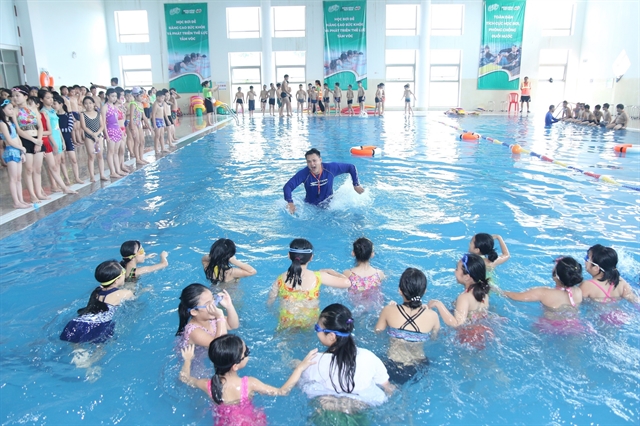 Society
Society


|
| A swimming lesson for pupils in Hà Nội. Besides swimming, emergency response and first aids skills are essential for children. VNA/VNS Photo |
HÀ NỘI — Lào Cai Province’s mountainous district of Bát Xát was left in a state of shock on Saturday following the devastating news that four schoolgirls had drowned in a local river.
Of the six girls who went to enjoy a relaxing dip that afternoon, only two made it out alive. The bodies of their four friends were recovered later the same day.
Despite the fact they could swim, it was not enough to save them.
In wake of the tragedy, experts have warned that water safety and lifesaving skills are crucial to help children fully enjoy summer days.
Chu Hương Giang, an eighth grader at Hà Nội’s Trâu Quỳ Secondary School, took part in a lifesaving course at Tùng Lâm Swimming Pool in mid-May.
“The course teaches us about potential threats. I learnt to swim in the sixth grade, but I don't I think it is enough. Being able to detect risks helps us to better respond in an emergency,” she told Hà Nội Mới newspaper.
At the pool, children and their parents are presented with different situations and taught about water safety and lifesaving skills, as well as first aid for drowning victims.
Trainer Dương Đức Quang from Gia Lâm District's Centre of Culture and Sports said the locality had many lakes and rivers which posed a threat to children.
“Parents are paying more attention to teaching their children how to swim and protecting themselves in water,” he said.
A swimming course takes up to 15 days and includes emergency response.
“In March, eight schoolboys drowned in Hoà Bình Province although they could all swim well,” he said.
“I always remind the students that knowing how to swim cannot protect them from drowning. Without the proper skills, they could easily die trying to save their friends.”
Deputy Prime Minister Vũ Đức Đam on May 20 urged parents, schools and local authorities to teach children how to swim and the dangers of water.
“It starts with learning to swim. However, knowing how to swim is not enough. Children must learn to prevent and respond to emergencies as well as how to save others,” he said.
Despite various measures being taken, 3,000 children still died from drowning per year due to a lack of swimming skills, poor supervision and natural disasters, according to a report by the Ministry of Labour, Invalids and Social Affairs compiled from 2010–2015.
The General Sports Office of Việt Nam – the agency in charge of the water safety programme – has set a goal of teaching children survival skills instead of focusing solely on swimming.
According to Nguyễn Thị Chiên, deputy head of the office’s sports department, to keep children away from water dangers, teachers needed to warn them against jumping into deep water or swimming too far from the shore.
In some sessions, students will wear casual clothes, not swimming suits, to experience emergency situations.
Tips on calling for help and first aid will also be provided to enhance water safety.
Drowning is one of the main causes of child deaths in Việt Nam.
In February 2016, Prime Minister Nguyễn Xuân Phúc issued a decision setting to cut the number of child drownings by at least six per cent from 2015 while raising the number of children trained to swim by 40 per cent by 2020. — VNS




